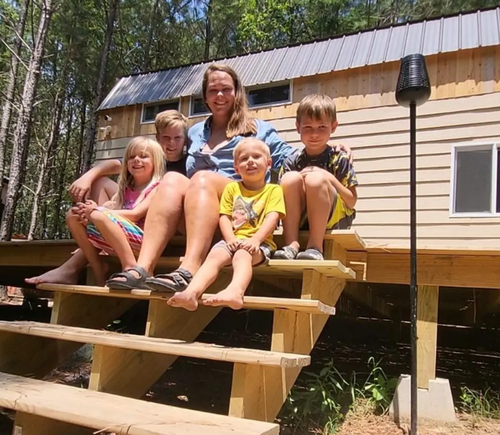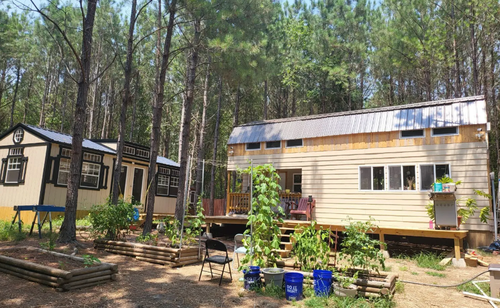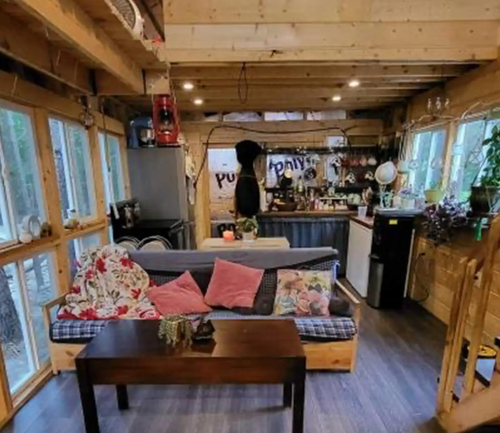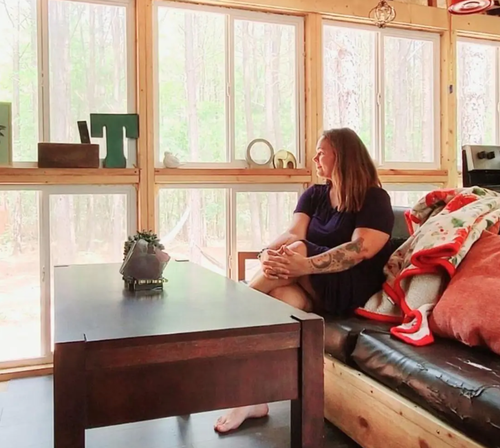
A family of six downsized from a single-family home into a 500-square-foot toolshed in northwest Arkansas after government-enforced COVID lockdowns of the 2020s paralyzed the economy and led to job loss and evaporation of personal savings.
"One of the things people find really weird about us living in a shed is that we use a composting bathroom rather than a traditional toilet," Jessica Taylor, 30, told NYPost, who lives in the shed with her husband Lath, and four children.
Taylor said the shed has the basics, such as electricity, running water, a heat/cooling system, a kitchen, and an entertainment space. One thing she noted is the toilet has a "bucket system ... and [when] you [urinate or defecate], you cover it with wood chips each time. After two days, whether the bucket is full or not, we dump [the waste] into a composting bin in the woods, and then after a couple of years, [the waste] turns into the soil for ornamental plants."
A combination of tax returns, stimulus checks, and unemployment distributions, plus $17,000 in savings, funded their housing project.
"More and more people are breaking free from the mindset that you have to have the big expensive, fancy house to feel like they're making it," said Taylor, adding, "there's value in living modestly. We can spend more time together gardening and enjoying nature rather than working to afford lavish accommodations."
Taylor explained that when she and her husband lost their jobs during the pandemic -- renting a $1,100 single-family home became unaffordable. The couple has reduced monthly expenses from $2,000 to $400.
"Since we moved into the shed, we've become really financially stable, and we're getting close to being debt-free," Taylor added. Their excess savings allowed them to expand the shed's footprint.
The timing of the so-called 'shed life' comes as the worst inflation in decades decimates lower-tier consumers, depleting their savings and purchasing power. People want to break free from the corporate system that has imprisoned them with insurmountable debts.
Tiny homes are only gaining more popularity as a tidal wave of evictions could be nearing, with 8.4 million Americans, or about 15% of all renters, behind rent payments in June.
A family of six downsized from a single-family home into a 500-square-foot toolshed in northwest Arkansas after government-enforced COVID lockdowns of the 2020s paralyzed the economy and led to job loss and evaporation of personal savings.
“One of the things people find really weird about us living in a shed is that we use a composting bathroom rather than a traditional toilet,” Jessica Taylor, 30, told NYPost, who lives in the shed with her husband Lath, and four children.
Taylor said the shed has the basics, such as electricity, running water, a heat/cooling system, a kitchen, and an entertainment space. One thing she noted is the toilet has a “bucket system … and [when] you [urinate or defecate], you cover it with wood chips each time. After two days, whether the bucket is full or not, we dump [the waste] into a composting bin in the woods, and then after a couple of years, [the waste] turns into the soil for ornamental plants.”
A combination of tax returns, stimulus checks, and unemployment distributions, plus $17,000 in savings, funded their housing project.
“More and more people are breaking free from the mindset that you have to have the big expensive, fancy house to feel like they’re making it,” said Taylor, adding, “there’s value in living modestly. We can spend more time together gardening and enjoying nature rather than working to afford lavish accommodations.”
Taylor explained that when she and her husband lost their jobs during the pandemic — renting a $1,100 single-family home became unaffordable. The couple has reduced monthly expenses from $2,000 to $400.
“Since we moved into the shed, we’ve become really financially stable, and we’re getting close to being debt-free,” Taylor added. Their excess savings allowed them to expand the shed’s footprint.
The timing of the so-called ‘shed life’ comes as the worst inflation in decades decimates lower-tier consumers, depleting their savings and purchasing power. People want to break free from the corporate system that has imprisoned them with insurmountable debts.
Tiny homes are only gaining more popularity as a tidal wave of evictions could be nearing, with 8.4 million Americans, or about 15% of all renters, behind rent payments in June.










